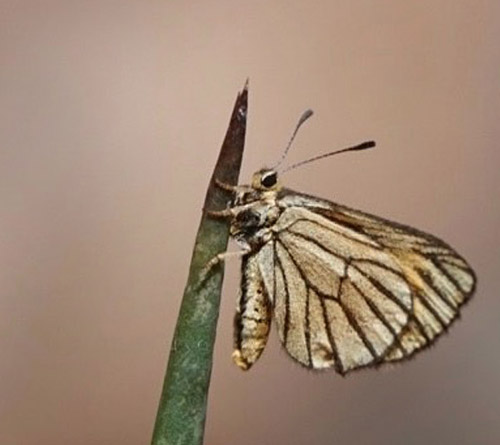Yellow
Zulu, Alaena
amazoula (Boisduval,
1847)
Description: Is a small yellow butterfly with
black ribs and a wide black border.
The wingspan is 22–28 mm for males and 25–32
mm for females.Habitat:
Is grassland or rocky areas in grassy savanna but
it also occurs in open forest. The yellow zulu is
found in localized colonies, often on the slopes
of stone-strewn hillsides.
Large numbers of specimens are sometimes found
within such a colony but usually less than a
dozen occur in a particular colony.
Behavior: The flight is
feeble and specimens alight frequently, usually
on grass stems. They may spend long periods
resting on grass stems. The butterfly closely
resembles a day-flying geometrid moth, both in
its appearance and flight pattern.
Flight time: The adults
fly in most months of the year, but they are
commoner from November to April. Peak numbers of
adults are found in December and January.
Food: The larval food has
been recorded as rock lichens, Lichenes by Clark & Dickson (1971) and
as algae, Cyanophyta on rocks by Pringle et al. (1994).
Distribution:
Alaena
a. amazoula (Boisduval,
1847): Cape
- Natal, Swaziland, Transvaal, Zambia &
Zimbabwe, Botswana.
A.
a. ochroma (Vári,
1976): Transvaal, Mozambique, Zambia &
Zimbabwe.
A.
a. congoana (Aurivillius,
1914): D. R. of the Congo, Angola, Namibia.
A.
a. nyasana (Hawker-Smith,
1933): Malawi.
Alaena genus with 25 species is a small
yellow butterfly in family Lycaenidae,
subfamily Poritiinae and
tribe Liptenini. That is found in central to
eastern and southern Africa.
What
do the larvae of Alaena amazoula feed on?
Mark
C. Williams December 2006 METAMORPHOSIS, VOL. 17, No. 4 140
|
